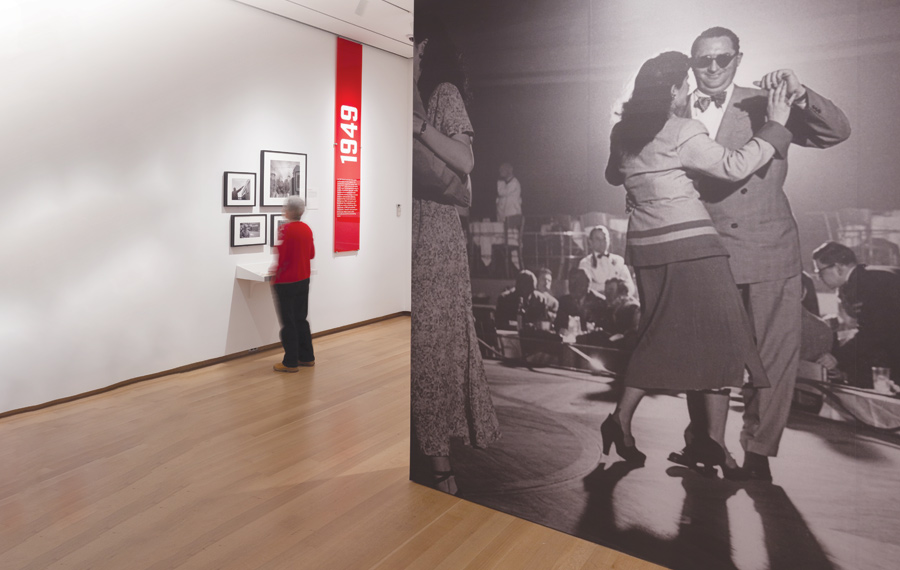 “Through a Different Lens: Stanley Kubrick Photographs”
Museum of the City of New York installation. Photo by Brad Farwell, courtesy of the Museum of the City of New York
“Through a Different Lens: Stanley Kubrick Photographs”
Museum of the City of New York installation. Photo by Brad Farwell, courtesy of the Museum of the City of New York Movie fans know Stanley Kubrick as the acclaimed director of “Dr. Strangelove,” “2001: A Space Odyssey,” “A Clockwork Orange” and “The Shining.” They may be less aware that a promising and pivotal five-year run as a photographer for the pictorial magazine “Look” preceded Kubrick’s illustrious film career.
Kubrick was 13 when his father bought him a Graflex camera, and three years later, the teen sold his first photo to “Look.” Over the next five years, Kubrick went from freelancer to apprentice to staff photographer, producing remarkable photo essays about the lives of New Yorkers, famous and unknown. An exhibition of these images titled “Through a Different Lens: Stanley Kubrick Photographs,” originally displayed at the Museum of the City of New York (MCNY) from April through October 2018, will open at the Skirball Cultural Center on Oct. 17.
Skirball curator Laura Mart was unaware of Kubrick’s photographic career before she learned of the MCNY exhibit. She instantly was interested. “One of the things we’re always looking for at the Skirball are stories of important Americans of Jewish heritage who’ve had pivotal roles in changing American culture,” Mart told the Journal.
Born in the Bronx in 1928, Kubrick was the grandson of Ashkenazi Jewish immigrants, and parents who were not religious or practicing Jews. “But for the focus of our exhibition and why we were interested in him, it was the weight of his contribution to American culture and filmmaking,” Mart said. “Stanley Kubrick is arguably one of the most important filmmakers of the 20th century, and although he wasn’t a particularly observant Jew, he was of Jewish ancestry.”
Presented chronologically, the exhibition shows each “Look” magazine layout with both published images and outtakes from the shoot. It begins with Kubrick’s first sale in 1945, depicting a dejected newspaper salesman on the day Franklin D. Roosevelt died, and ends in 1950, when he shot luminaries including conductor-composer Leonard Bernstein and boxer Rocky Graziano. In between, Kubrick’s subjects included subway riders, circus performers, showgirls and a dentist’s patients. He also photographed sporting events and street scenes.
“One of the things that interested me from a curatorial perspective was the way Kubrick looked at human interaction,” Mart said. “He photographed celebrities, but his focus was more on the human connection between everyday people that he turned into almost cinematic stories. We found it to be tremendously interesting from a perspective of looking at his formative years and how he developed his eye as a filmmaker. There are some images in the exhibition that have a very clear connection to his early film work.”
Sean Corcoran, co-curator of the original MCNY exhibition, concurred. “You see the development of Kubrick’s talent over five years that provides a window into the work he’s known for later on,” Corcoran said. “He learned lighting techniques, framing, composition — the skills of seeing. He also learned the art of observation, seeing people and knowing how to record them on film, capture human interactions and how people communicate without words. He also learned how to work within a system and how to accomplish goals — something you have to learn in order to make a film.”
Corcoran explained the MCNY acquired the “Look” archives — approximately 300,000 pictures — 70 years ago, but most of the material was in negative and contact-sheet form. Once the museum staff began digitizing the images, it realized that roughly 15,000 photos were Kubrick’s. The curators then selected representative examples, “assignments that exemplified important moments in his development as a photographer and those that would have the most public interest while representing the larger body of work,” Corcoran said. Of the nearly 150 images, Corcoran is partial to an unpublished shoeshine-boy photo essay, which he calls “a remarkable slice of life.”
“[Kubrick] photographed celebrities, but his focus was more on the human connection between
everyday people that he turned into almost
cinematic stories.”
— Laura Mart
The display also includes Kubrick’s first film, the 1951 short “Day of the Fight,” which was drawn directly from his assignment on boxer Walter Cartier two years before. The photos served as his storyboard. A clip from the 1955 film “Killer’s Kiss” also is on view, and a companion book featuring every assignment on display plus additional images will be available. “It’s meant to give a more in-depth overview of his time at the magazine,” Corcoran, the book’s co-author, said.
He imagines Kubrick, who died in 1999, would like the exhibition. “I’ve heard interviews made in the 1960s where Kubrick reflects on the time as a photographer, and he says his years at ‘Look’ were his college education, and if he had gone to university, he never would have become a director,” Corcoran said. “He looked back on those years as formative and instrumental.”
Mart thinks it would “interest [Kubrick] to know that his reputation in pop culture has grown to such a stature that they want to know what his early work was like. I think most people will enjoy these works, which are compositionally beautiful and fascinating, subject-wise, with a beautifully framed film-noir aesthetic. They’re quirky and fun and offbeat,” she said. “People who love photography will love this show.”
“Through a Different Lens: Stanley Kubrick Photographs” runs from Oct. 17-March 8 at the Skirball Cultural Center.





















 More news and opinions than at a Shabbat dinner, right in your inbox.
More news and opinions than at a Shabbat dinner, right in your inbox.